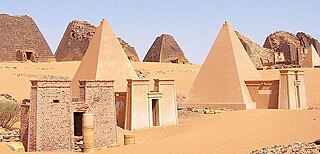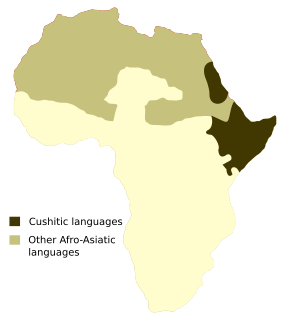
The Cushitic languages are a branch of the Afroasiatic language family. They are spoken primarily in the Horn of Africa, as well as the Nile Valley, and parts of the African Great Lakes region by Cushitic peoples.
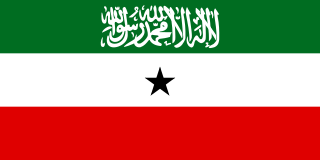
Somaliland, officially the Republic of Somaliland, is a self-declared state, internationally considered to be an autonomous region of Somalia.
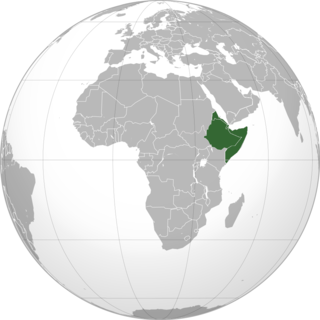
The Horn of Africa is a peninsula in Northeast Africa. It extends hundreds of kilometers into the Arabian Sea and lies along the southern side of the Gulf of Aden. The area is the easternmost projection of the African continent. Referred to in ancient and medieval times as the land of the Barbara and Habesha, the Horn of Africa denotes the region containing the countries of Djibouti, Eritrea, Ethiopia, and Somalia.
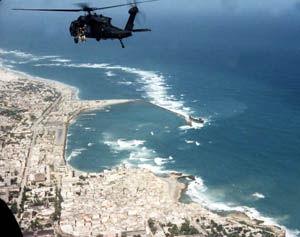
The Battle of Mogadishu, or Day of the Rangers, was part of Operation Gothic Serpent. It was fought on 3–4 October 1993, in Mogadishu, Somalia, between forces of the United States—supported by UNOSOM II—and Somali militiamen loyal to the self-proclaimed president-to-be Mohamed Farrah Aidid. The battle is also referred to as the First Battle of Mogadishu, to distinguish it amongst the nine major Battles of Mogadishu during the decades-long Somali Civil War.
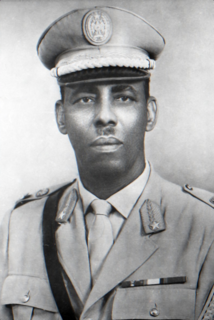
Jaalle Mohamed Siad Barre was a Somali politician who served as the President of the Somali Democratic Republic from 1969 to 1991.

The Somali Regional State, is the largest and easternmost of the nine ethnic divisions (kilimo) of Ethiopia. The state borders the Ethiopian states of Afar, the chartered city Dire Dawa, Oromia to the west, as well as Djibouti to the north, Somalia to the north, east, and south, and Kenya to the south-west.

Ogaden is the historical name of the modern Somali Region, the territory comprising the eastern portion of Ethiopia formerly part of the Hararghe province. The inhabitants are predominantly ethnic Somalis. The Ogaden (clan) of the Darod constitute the majority in the region, although this is disputed. Other Somali clans in the region are Isaaq,Gadabuursi, Issa and Hawiye clans.

The Somalis are an ethnic group belonging to the Cushitic peoples inhabiting the Horn of Africa. The overwhelming majority of Somalis speak the Somali language, which is part of the Cushitic branch of the Afroasiatic family. They are predominantly Sunni Muslim. Ethnic Somalis number around 28-30 million and are principally concentrated in Somalia, Ethiopia, Kenya, and Djibouti (534,000). Somali diasporas are also found in parts of the Middle East, North America, Western Europe, African Great Lakes region, Southern Africa and Oceania.
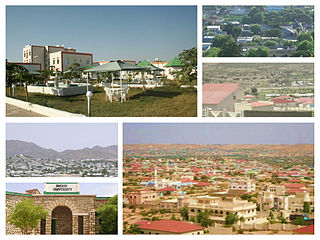
Borama is the capital and the largest city of the northwestern Awdal region of Somaliland. The commercial seat of the province, it is situated near the border with Ethiopia.

Laas Geel, also spelled Laas Gaal, are cave formations on the rural outskirts of Hargeisa, Somaliland. They contain some of the earliest known cave paintings in the Horn of Africa. Laas Geel's rock art is estimated to date to somewhere between 9,000 and 3,000 years BC.
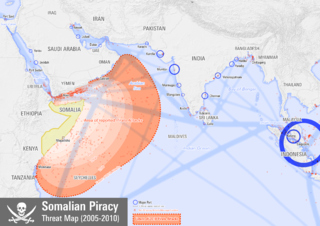
Piracy off the coast of Somalia refers to criminal violence and threats by Somalian pirates in the Gulf of Aden, Guardafui Channel and Somali Sea, in what some say are disputed territorial waters. It had primarily been a threat to international fishing vessels, expanding to international shipping since the second phase of the Somali Civil War, around 2000.

Somali studies is the scholarly term for research concerning Somalis and Greater Somalia. It consists of several disciplines such as anthropology, sociology, linguistics, historiography and archaeology. The field draws from old Somali chronicles, records and oral literature, in addition to written accounts and traditions about Somalis from explorers and geographers in the Horn of Africa and the Middle East. The Somali Studies International Association is the primary organization for Somalist scholars. Bildhaan, Somali Studies, Horn of Africa and the Anglo-Somali Society Journal likewise serve as the field's main periodicals. Since 1980, prominent Somalist scholars from around the world have also gathered annually to hold the International Congress of Somali Studies.

Somali architecture is the engineering and designing of multiple different construction types such as stone cities, castles, citadels, fortresses, mosques, temples, aqueducts, lighthouses, towers and tombs during the ancient, medieval and early modern periods in Somalia and other regions inhabited by Somalis, as well as the fusion of Somalo-Islamic architecture with Western designs in contemporary times.

Sports in Somalia are regulated by the Ministry of Sports of Somalia. The government ministry works closely with the Somali Olympic Committee and various sports governing bodies, including the Somali Football Federation. The first person of Somali descent to win an Olympic medal was Buuhoodlian Mohamed Suleiman. The athlete with the highest amount of Somali national records is Las Anodian Abdi Bile. Bile, who holds nine national records, is Somalia's most decorated athlete in history.
Tourism in Somalia is regulated by the Federal Government of Somalia's Ministry of Tourism. The industry was traditionally noted for its numerous historical sites, beaches, waterfalls, mountain ranges and national parks. After the start of the civil war in the early 1990s, the Tourism Ministry shut down operations. It was re-established in the 2000s, and once again oversees the national tourist industry. The Mogadishu-based Somali Tourism Association (SOMTA) provides on-the-ground consulting services.

Somali nationalism (Somali:Soomaalinimo) is centered on the notion that the Somali people share a common language, religion, culture and ethnicity, and as such constitute a nation unto themselves. The ideology's earliest manifestations are often traced back to the resistance movement led by Mohammed Abdullah Hassan's Dervish movement at the turn of the 20th century. In northwestern present-day Somalia, the first Somali nationalist political organization to be formed was the Somali National League (SNL), established in 1935 in the former British Somaliland protectorate. In the country's northeastern, central and southern regions, the similarly-oriented Somali Youth Club (SYC) was founded in 1943 in Italian Somaliland, just prior to the trusteeship period. The SYC was later renamed the Somali Youth League (SYL) in 1947. It became the most influential political party in the early years of post-independence Somalia.

This is a list of Somali aristocratic and court titles that were historically used by the Somali people's various sultanates, kingdoms and empires. Also included are the honorifics reserved for Islamic notables as well as traditional leaders and officials within the Somali customary law (xeer), in addition to the nobiliary particles set aside for distinguished individuals.
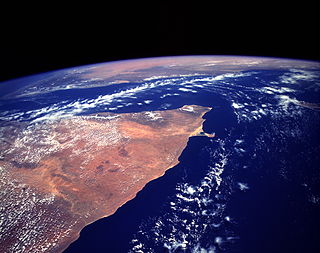
The Somali Sea is a body of water that borders the eastern coast of Somalia.






